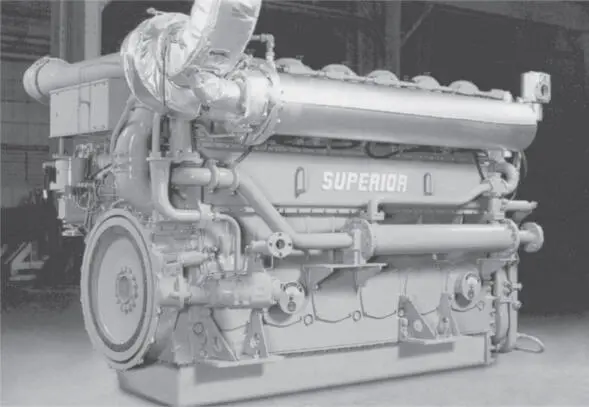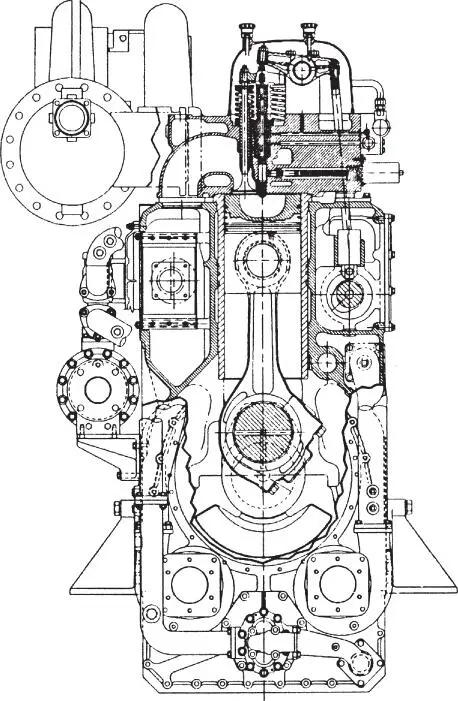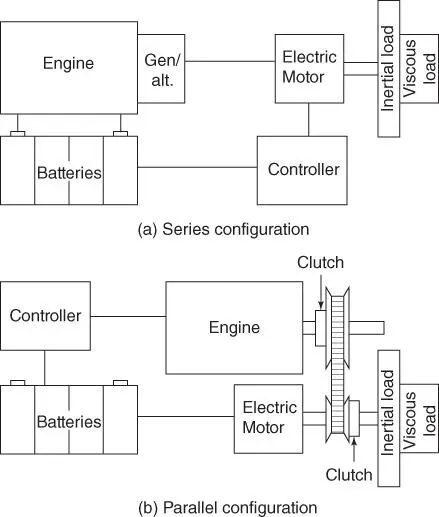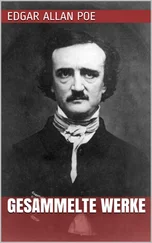
Figure 1.23A 94 L L8 stationary natural gas engine. (Courtesy of Cooper Energy Services, Inc.)

Figure 1.24Cutaway view of 94 L L8 stationary natural gas engine. (Courtesy of Cooper Energy Services, Inc.)
1.7 Alternative Powertrain Technology
In this section, alternative powertrain technology, including electric motors, fuel cells, and gas turbines, are discussed in terms of a particular application where they have some advantage over the internal combustion engine.
Electric motors compete with internal combustion engines in the range of powers less than about 500 kW. Driven by the need to adopt low‐carbon technology both for  emission reduction and for improvement of outdoor air quality, the pace of change in vehicle electrification has been far faster than envisioned. Vehicle manufacturers are moving from viewing electric motors as a secondary or back‐up source toward adopting electric motors as the primary power source and internal combustion engines as the secondary power source.
emission reduction and for improvement of outdoor air quality, the pace of change in vehicle electrification has been far faster than envisioned. Vehicle manufacturers are moving from viewing electric motors as a secondary or back‐up source toward adopting electric motors as the primary power source and internal combustion engines as the secondary power source.
Electric vehicles have a number of advantages over internal combustion vehicles. Electric vehicles are quiet, have lower vibration levels, and cost less to operate, about 1 cent per mile versus 10 cents per mile for internal combustion vehicles. Electric motors have been developed that have high torque‐speed characteristics superior to those of internal combustion engines, and also provide up to 150 kW per wheel. Most of the electric motors currently used in hybrid and electric vehicles are brushless DC motors, with rotor‐mounted permanent magnets. However, use of AC induction motors, in which the rotating magnetic field is produced by electric currents in the stator, is increasing due to their lower cost, and less complex incorporation into the engine powertrain. Electric motor performance maps that contain contours of motor efficiency on a torque‐speed plane are used to choose electric motors for vehicular applications.
Proponents of electric vehicles point out that almost any fuel, solar photovoltaic panels, or wind turbines can be used to generate the electricity used by an electric vehicle, reducing dependence on fossil fuels. There would be no local fossil fuel exhaust emissions emitted by the electric vehicle in an urban environment. However, if the electricity is generated by a power plant using coal as a fuel, the air pollution generated by the coal power plant would negate the air‐quality advantage of the electric vehicle.
The main problem with electric vehicles is the batteries used for energy storage. It is generally recognized that a breakthrough in battery technology is required if electric vehicles are to become a significant part of the automotive fleet. Battery packs for vehicles are generally assembled from groups of individual lithium ion batteries, with a total mass of about 3500 kg, and have a life span of about 5 years. The battery pack capacity for automobiles varies from about 25–100 kWh, and fully electric urban buses are equipped with batteries with capacities from 600 to 1000 kWh. The electric vehicles that have been built to date have a limited range of only 100–200 mi (160–320 km), on the order of one‐half of what can be easily realized with a gasoline engine–powered vehicle.
In addition, the volumetric energy density of a lithium ion battery is currently 0.5–1 MJ/L (150–300 Wh/L), with energy densities of the order of 5 MJ/L under development, significantly lower than gasoline or diesel fuels with energy densities of the order of 35 MJ/L. In cold weather, there is a degradation of battery performance of the order of 15‐30%. A nationwide network of high voltage (240 to 950 V) charging stations is needed to compensate for the limited range of electric vehicles. The charging time for electric car batteries is at least two hours, depending on the charging station voltage, in comparison to a liquid fuel refueling time of the order of a few minutes.
Hybrid electric vehicles (HEV), which incorporate a small internal combustion engine with an electric motor and storage batteries, have reached the production stage, primarily due to their low fuel consumption and emission levels. A hybrid electric vehicle has an internal combustion engine to provide the energy to meet vehicle range requirements. The battery then provides the additional power needed for acceleration and climbing hills. The battery in an HEV vehicle typically has a capacity of about 50 MJ (14 kWh). Hybrid electric vehicles have a long history, as the first HEV, the Woods Dual Power automobile, was introduced in 1916. A similar engine‐motor‐battery combination has been used on diesel‐electric submarines since 1900 to allow both surface and underwater operation.
As shown in Figure 1.25, two elementary configurations for an HEV are series or parallel configurations. In a series configuration, only the electric motor with power from the battery or generator is used to drive the wheels. The internal combustion engine is maintained at its most efficient and lowest emission operating points to run the generator and charge the storage batteries. With the parallel configuration, the engine and electric motor can be used separately or together to power the vehicle. Some hybrid vehicles use an internal combustion engine to power the front wheels and an electric motor to power the rear wheels, and they synchronize them to provide all‐wheel drive capability. The motors are used as generators during braking to increase vehicle efficiency.

Figure 1.25Hybrid electric vehicle powertrain configurations.
A fuel cell converts the chemical energy in a fuel directly to electricity through electrochemical reactions. The first fuel cell was invented by W. Grove, an English scientist, in 1838. For vehicular applications, hydrogen is used as the fuel, and oxygen is the oxidizing agent. Fuel cell technology competes well in applications requiring reduced emissions, as recent developments in polymer‐electrolyte membrane (PEM) technology indicate that a PEM fuel cell produces much lower  emissions relative to an internal combustion engine. A PEM fuel cell operates with hydrogen supplied to the anode, and oxygen supplied to the cathode.
emissions relative to an internal combustion engine. A PEM fuel cell operates with hydrogen supplied to the anode, and oxygen supplied to the cathode.
Both the anode and cathode are composed of platinum particles embedded in a substrate surface of porous carbon. At the anode, the hydrogen is split into protons  and electrons
and electrons  in the reaction
in the reaction  . The protons migrate through a polymer electrolyte to the cathode, and the electrons provide the required current across the external load circuit, such as a battery. At the cathode, the oxygen reacts with the protons and electrons to form water, in the reaction
. The protons migrate through a polymer electrolyte to the cathode, and the electrons provide the required current across the external load circuit, such as a battery. At the cathode, the oxygen reacts with the protons and electrons to form water, in the reaction  .
.
Читать дальше



 emission reduction and for improvement of outdoor air quality, the pace of change in vehicle electrification has been far faster than envisioned. Vehicle manufacturers are moving from viewing electric motors as a secondary or back‐up source toward adopting electric motors as the primary power source and internal combustion engines as the secondary power source.
emission reduction and for improvement of outdoor air quality, the pace of change in vehicle electrification has been far faster than envisioned. Vehicle manufacturers are moving from viewing electric motors as a secondary or back‐up source toward adopting electric motors as the primary power source and internal combustion engines as the secondary power source.
 emissions relative to an internal combustion engine. A PEM fuel cell operates with hydrogen supplied to the anode, and oxygen supplied to the cathode.
emissions relative to an internal combustion engine. A PEM fuel cell operates with hydrogen supplied to the anode, and oxygen supplied to the cathode. and electrons
and electrons  in the reaction
in the reaction  . The protons migrate through a polymer electrolyte to the cathode, and the electrons provide the required current across the external load circuit, such as a battery. At the cathode, the oxygen reacts with the protons and electrons to form water, in the reaction
. The protons migrate through a polymer electrolyte to the cathode, and the electrons provide the required current across the external load circuit, such as a battery. At the cathode, the oxygen reacts with the protons and electrons to form water, in the reaction  .
.










